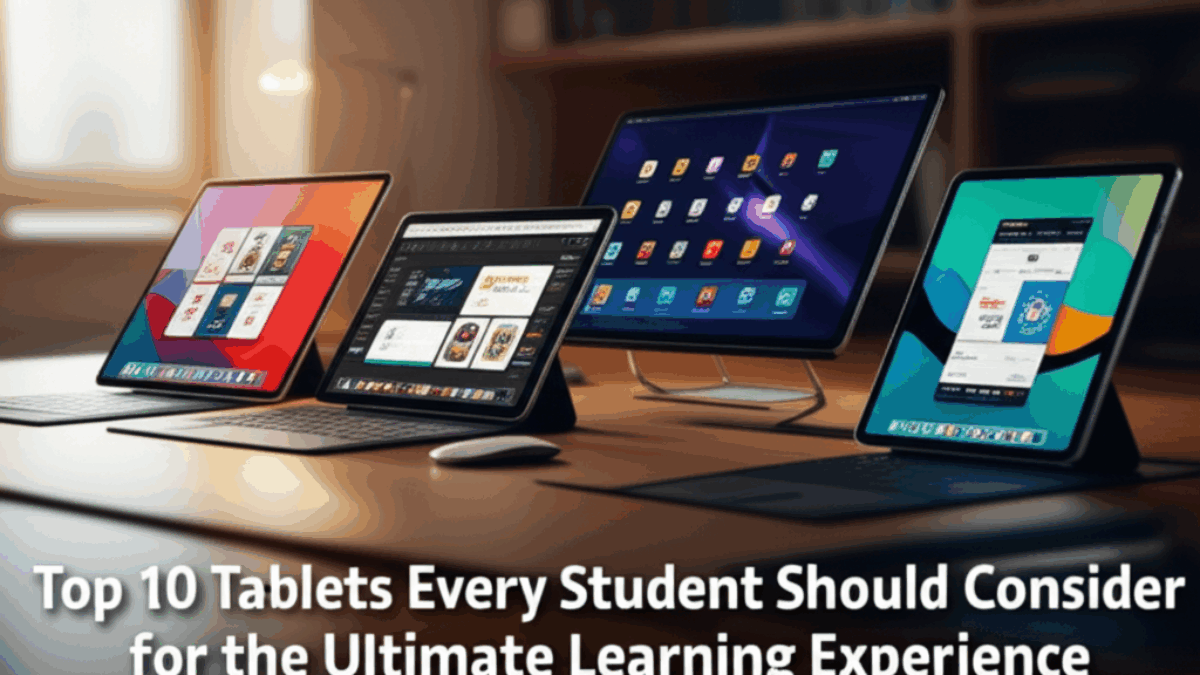Introduction: Why Tablets are Trending for Education
In an era where technology is integral to education, the tablet has emerged as a versatile learning tool that caters to a variety of academic needs. Whether it’s for researching, taking notes, or engaging in interactive learning, tablets have become a staple in many students’ arsenals. Portable, lightweight, and equipped with a host of applications, tablets provide a seamless bridge between traditional learning and digital resources.
This trend is further fueled by the hybrid learning approaches adopted by many educational institutions, combining in-person instruction with online resources. Tablets offer the adaptability students need, enhancing their educational experience while allowing them to remain connected.
Key Features to Look For
Choosing the right tablet requires understanding the essential features that can impact your learning experience. Here’s a detailed look at what to consider:
1. Screen Size and Resolution
- Screen Size: A tablet with a minimum screen size of 10 inches is ideal for reading e-books, taking notes, or watching lectures. Larger screens provide better visibility and multitasking capabilities.
- Resolution: Higher resolution (at least 1080p) is crucial for displaying text and images clearly, reducing eye strain during prolonged use.
2. Battery Life
- A long-lasting battery (8 hours or more) is essential for students who spend long hours in classes or libraries. The ability to get through an entire day without needing a charge is crucial.
3. Performance
- Processor: A tablet with a powerful processor (like Apple’s M1 or Snapdragon 888) ensures smooth multitasking and operation.
- RAM: At least 4GB of RAM is recommended for seamless operation, especially when running multiple apps simultaneously.
4. Storage Capacity
- Look for a tablet with at least 64GB of storage. This allows ample space for downloading apps, storing documents, and keeping educational resources. Tablets with expandable storage options (via microSD) offer additional flexibility.
5. Operating System
- Choose between Android, iOS, or Windows based on your needs and preferences. iOS is known for its user-friendly interface and optimization, while Android offers more flexibility and customization options. Windows is more compatible with professional software.
6. Stylus and Keyboard Support
- For note-taking and creative tasks, a tablet that supports a stylus can enhance your experience. Additionally, keyboards (whether detachable or Bluetooth) can convert your tablet into a mini-laptop for typing-heavy tasks.
7. Connectivity
- Make sure the tablet supports Wi-Fi (ideally Wi-Fi 6) for faster internet speeds. Many tablets also offer cellular options (4G/5G), providing access to the internet even without Wi-Fi.
8. Durability
- Look for tablets that are built to last. Features like Corning Gorilla Glass and water resistance can protect your device from accidental drops and spills.
Comparison of Top Products in the Market
Let’s delve into the top tablets that stand out in various categories suitable for students:
1. Apple iPad Pro (11-inch)
- Pros: Exceptional performance, excellent display quality, seamless integration with other Apple products, strong app ecosystem.
- Cons: Higher price point, limited customization beyond iOS.
2. Samsung Galaxy Tab S8
- Pros: Excellent screen quality, comes with S Pen, multitasking capabilities, expandable storage.
- Cons: Samsung’s software updates can be slower than Apple’s.
3. Microsoft Surface Pro 8
- Pros: Full Windows experience, great for professional use, detachable keyboard available, high-quality design.
- Cons: Pricey compared to typical tablets, heavier than other options.
4. Lenovo Tab P11 Plus
- Pros: Affordable, decent performance, good battery life, includes Kids Mode.
- Cons: Average display resolution, slower software updates.
5. Amazon Fire HD 10
- Pros: Budget-friendly, good battery life, access to Amazon’s ecosystem, decent performance for basic tasks.
- Cons: Limited app selection, lower build quality compared to competitors.
6. Asus ZenPad 3S 10
- Pros: Sleek design, good audio quality, decent performance for everyday tasks.
- Cons: Limited software update support, lower camera quality.
7. Apple iPad (9th Generation)
- Pros: Affordable, great performance for the price, robust app ecosystem, solid battery life.
- Cons: Older design compared to iPad Pro, lacks ProMotion feature.
8. Samsung Galaxy Tab A7
- Pros: Affordable, decent performance for media consumption, good display quality.
- Cons: Limited app performance for heavy multitasking, average camera quality.
9. Microsoft Surface Go 3
- Pros: Affordable Windows device, lightweight, good for general tasks.
- Cons: Limited performance for heavy tasks, optional keyboard sold separately.
10. Huawei MatePad Pro
- Pros: Great display, good performance, supports stylus (M-Pencil) and keyboard.
- Cons: Limited Google services, not widely available in some regions.
Use-Case Scenarios
For Students
Students benefit from tablets with note-taking capabilities, lightweight designs, and solid battery life. The Apple iPad Pro and Samsung Galaxy Tab S8 are excellent options due to their stylus support and productive apps.
For Professionals
For those working on more intensive tasks or requiring software like Microsoft Office, the Microsoft Surface Pro 8 is ideal due to its full Windows OS capability.
For Gamers
Tablets with high-resolution screens and solid performance (like the iPad Pro) can serve as entertainment hubs, perfect for gaming during breaks.
Expert Recommendations: Budget vs Premium Choices
Budget Choices
- Amazon Fire HD 10: Perfect for basic tasks, media consumption, and reading. It offers great value for those on a tight budget.
- Lenovo Tab P11 Plus: Offers a good balance of performance and affordability, ideal for students who need a reliable all-rounder.
Premium Choices
- Apple iPad Pro: Best for those who want a top-notch experience in design, performance, and app availability. Perfect for creative professionals and advanced multitaskers.
- Microsoft Surface Pro 8: A solid choice for students who need a powerful device capable of running full desktop applications.
FAQs
Q1: Can I use a tablet for college?
Absolutely! Tablets are excellent for taking notes, reading e-books, and completing assignments. Many tablets even offer keyboard accessories that make typing essays easier.
Q2: Are tablets good for reading?
Yes, with high-resolution screens and formats compatible with various eBook services, tablets can provide a comfortable reading experience.
Q3: How do I maintain my tablet?
Keep it updated, use a quality case, avoid exposure to extreme conditions, and clean the screen regularly to maintain functionality and longevity.
Q4: Should I buy a stylus for my tablet?
If you plan to take handwritten notes or sketch, a stylus can enhance your experience significantly, especially with tablets like the iPad Pro or Galaxy Tab S8.
Buyer’s Checklist for Quick Decision-Making
- Determine Your Budget: Identify how much you are willing to spend.
- Define Your Use Cases: Think about whether you need it for studying, gaming, or professional tasks.
- Evaluate Key Features:
- Screen Size & Resolution
- Battery Life
- Performance Specifications
- Storage Options
- Connectivity
- Check Accessory Compatibility: Ensure compatibility with keyboards and styluses.
- Research Brand Reliability: Look for reviews and customer feedback to assess quality and support.
- Consider Future Needs: Select a device that can grow with your usage needs.
Conclusion
Choosing the right tablet can significantly enhance your learning experience, making it essential to select one that fits your academic needs and lifestyle. From entry-level choices to premium powerhouses, there’s a tablet for every student. The right investment will not only aid in studies but can also serve functional purposes in your daily life, making it a worthwhile addition to your tech arsenal. As technology continues to evolve, being equipped with the right tools is more crucial than ever for academic success. Happy studying!

